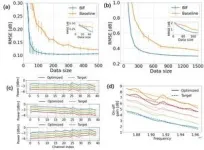(Press-News.org) With the emergence of internet services such as AI-generated content and virtual reality, the demand for global capacity has surged, significantly intensifying pressures on fiber-optic communication systems. To address this surge and reduce operational costs, efforts are underway to develop autonomous driving optical networks (ADONs) with highly-efficient network operations. One of the most important tasks for an ADON is to accurately model and control the optical power evolution (OPE) over fiber links, since it determines the level of impairment noise and signal transmission quality. In fiber-optic communication systems, the optical power of signals evolves over the fiber and varies across different wavelengths, presenting a complex physical process, especially for multiband systems with severe Kerr nonlinearity and interchannel stimulated Raman scattering.
In multiband ADONs, OPE is mainly influenced by fiber propagation and amplification processes. In particular, the primary challenge in modeling and controlling OPE lies in optical amplifiers (OAs). Data-driven approaches are able to achieve high accuracy. However, traditional data-driven methods, especially neural networks (NNs), demand extensive data to construct accurate digital twin models, leading to significant measurement costs. While some approaches can minimize required measurements through techniques like transfer learning or integrating physical knowledge, the perspective of data selection has received scant attention.
Recently, researchers from Shanghai Jiao Tong University (SJTU), Shanghai, China, proposed a Bayesian inference framework (BIF) to efficiently model and control the optical power evolutions in fiber-optic communication systems. Their research is reported in Advanced Photonics. Leveraging Bayesian theory, the BIF selects the next to-be-measured spectrum/OA configuration by both the performance estimation and uncertainty analysis. This approach enables simultaneous exploitation and exploration of a data space to identify the most suitable candidates, thus reducing the requisite data size.
The researchers conducted extensive experiments and simulations in C+L-band fiber-optic transmission systems, to model and control the OPE with heterogenous OAs, including an erbium-doped fiber amplifier (EDFA) and a Raman amplifier (RA). Compared with the NN-based modeling methods using randomly collected data, the proposed BIF can reduce the data needed for modeling by over 80 percent with an EDFA, and by over 60 percent with an RA. In terms of control, iterative adjustments of signal spectra and pump configurations were conducted, achieving arbitrary target gain/power spectra within fewer than 30 iterations.
This work provides an efficient approach to select data for measuring in a sequential manner. The measured data can be learned immediately to guide the next round of data collecting and optimization, thus achieving data-efficient modeling and controlling for OPE. Besides, the probabilistic analysis of the proposed framework shows a potential in reliability analysis for network operations, which is of vital importance for ADON.
According to corresponding author Prof. Qunbi Zhuge of SJTU, “The proposed framework can be a promising technical path for realizing data-driven ADON in future optical networks.”
For details, see the original Gold Open Access article by Liu et al., “Digital twin modeling and controlling of optical power evolution enabling autonomous-driving optical networks: a Bayesian approach,” Adv. Photon. 6(2) 026006 (2024), doi 10.1117/1.AP.6.2.026006.
END
Optical power evolution in fiber-optic networks: New framework for better modeling and control
Researchers develop a data-efficient approach to manipulating optical power evolutions for high-capacity optical communications
2024-05-10
ELSE PRESS RELEASES FROM THIS DATE:
Therapeutic opportunities for hypermutated urothelial carcinomas beyond immunotherapy
2024-05-10
“These results argue that combinations based on immunotherapy may also provide an opportunity for targeting urothelial cancers with low TMB, and provide efficacy superior to classic chemotherapy.”
BUFFALO, NY- May 10, 2024 – A new editorial paper was published in Oncoscience (Volume 11) on April 25, 2024, entitled, “Therapeutic opportunities for hypermutated urothelial carcinomas beyond immunotherapy.”
In this new editorial, researcher Ioannis A. Voutsadakis from Sault Area Hospital and Northern Ontario School of Medicine discusses tumor mutation burden (TMB)—a ...
UC Santa Cruz study discovers cellular activity that hints recycling is in our DNA
2024-05-10
By Rose Miyatsu, UC Santa Cruz Genomics Institute
Although you may not appreciate them, or have even heard of them, throughout your body, countless microscopic machines called spliceosomes are hard at work. As you sit and read, they are faithfully and rapidly putting back together the broken information in your genes by removing sequences called “introns” so that your messenger RNAs can make the correct proteins needed by your cells.
Introns are perhaps one of our genome’s biggest mysteries. They are DNA sequences that interrupt the sensible protein-coding information ...
A retrospective look at Human Computer Interaction - free public lecture by Professor Manolya Kavakli
2024-05-10
Professor Manolya Kavakli is an expert in gamification
Her talk will examine the complex relationship between humans, computers and tech
She will examine how digital developments have the potential to improve lives and modernise industry.
The latest inaugural lecture at Aston University will look at the complex relationship between humans, computers and technology.
Professor Manolya Kavakli will discuss progress so far and offer insights into how to ease into digital transformation for the challenges that lie ahead.
The professor is an expert in gamification, the process of using elements of gaming in non-gaming situations such as learning and training.
She ...
Reducing prejudice in war zones proves challenging
2024-05-10
There are 62.5 million internally displaced persons worldwide, according to 2022 data by the UNHCR, the United Nations Refugee Agency. These individuals were forced to leave their homes but remain in the same country.
Prior research has shown that internally displaced persons often experience prejudice and discrimination, as residents in their new locale fear that the migrants may be insurgents or criminals, or compete for jobs.
Now, a new Dartmouth study involving Afghanistan indicates that changing such attitudes is an uphill battle. Given the decades of fighting there, Afghanistan has had one of the largest populations ...
Chapman professor contributes to breakthrough hemostasis and wound healing research
2024-05-10
A breakthrough study, published in Science Translational Medicine, features a biomedical engineering innovation with the potential to transform trauma care and surgical practices. Chapman University’s Fowler School of Engineering Founding Dean and Professor, Andrew Lyon, is a member of this multidisciplinary, multi-university scientific research team developing platelet-like particles that integrate into the body’s clotting pathways to stop hemorrhage. Sanika Pandit, an alumna of Chapman University, is also among the 15 authors in this research.
Addressing a longstanding gap in surgical and trauma care, this advancement holds potential for patient implementation. Patients ...
Melanoma in darker skin tones: Race and sex play a role, Mayo study finds
2024-05-10
ROCHESTER, Minn. — Melanoma, an aggressive form of skin cancer that accounts for 75% of all skin-cancer-related deaths, is often detected later in people with darker skin complexions — and the consequences can be devastating, a Mayo Clinic study reveals.
While melanoma may be found less frequently in people with darker complexions than fair ones, this potentially serious form of cancer can strike anyone. The study, which consisted of 492,597 patients with melanoma, suggests that added vigilance in early screening is particularly needed for Black men, whose cancers ...
Visual experiences unique to early infancy provide building blocks of human vision, IU study finds
2024-05-10
What do infants see? What do they look at? The answers to these questions are very different for the youngest babies than they are for older infants, children and adults. Characterized by a few high-contrast edges in simple patterns, these early scenes also contain the very materials needed to build a strong foundation for human vision.
That is the finding of a new study, “An edge-simplicity bias in the visual input to young infants,” published on May 10 in Science Advances by IU researchers Erin Anderson, Rowan Candy, Jason Gold and Linda Smith.
“The starting ...
Clues from deep magma reservoirs could improve volcanic eruption forecasts
2024-05-10
New research into molten rock 20km below the Earth’s surface could help save lives by improving the prediction of volcanic activity.
Volcanic eruptions pose significant hazards, with devastating impacts on both people living nearby and the environment.
They are currently predicted based on activity of the volcano itself and the upper few kilometres of crust beneath it, which contains molten rock potentially ready to erupt.
However, new research highlights the importance of searching for ...
Scientists unlock key to breeding ‘carbon gobbling’ plants with a major appetite
2024-05-10
The discovery of how a critical enzyme “hidden in nature’s blueprint” works sheds new light on how cells control key processes in carbon fixation, a process fundamental for life on Earth.
The discovery, made by scientists from The Australian National University (ANU) and the University of Newcastle (UoN), could help engineer climate resilient crops capable of sucking carbon dioxide from the atmosphere more efficiently, helping to produce more food in the process.
The research, published in Science Advances, demonstrates a previously unknown function of an enzyme called carboxysomal carbonic anhydrase (CsoSCA), which is found in cyanobacteria – also called ...
Hubble celebrates the 15th anniversary of servicing Mission 4
2024-05-10
Fifteen years ago, human hands touched NASA's Hubble Space Telescope for the last time.
As astronauts performed finishing tasks on the telescope during its final servicing mission in May 2009, they knew they had successfully concluded one of the most challenging and ambitious series of spacewalks ever conducted. But they couldn’t have known at the time what an impact they had truly made.
“I had high hopes that Hubble would last at least five years more, and maybe even a little more to overlap with Webb,” said astronaut and former associate administrator for NASA's Science Mission Directorate John ...
LAST 30 PRESS RELEASES:
Many mothers in Norway do not show up for postnatal check-ups
Researchers want to find out why quick clay is so unstable
Superradiant spins show teamwork at the quantum scale
Cleveland Clinic Research links tumor bacteria to immunotherapy resistance in head and neck cancer
First Editorial of 2026: Resisting AI slop
Joint ground- and space-based observations reveal Saturn-mass rogue planet
Inheritable genetic variant offers protection against blood cancer risk and progression
Pigs settled Pacific islands alongside early human voyagers
A Coral reef’s daily pulse reshapes microbes in surrounding waters
EAST Tokamak experiments exceed plasma density limit, offering new approach to fusion ignition
Groundbreaking discovery reveals Africa’s oldest cremation pyre and complex ritual practices
First breathing ‘lung-on-chip’ developed using genetically identical cells
How people moved pigs across the Pacific
Interaction of climate change and human activity and its impact on plant diversity in Qinghai-Tibet plateau
From addressing uncertainty to national strategy: an interpretation of Professor Lim Siong Guan’s views
Clinical trials on AI language model use in digestive healthcare
Scientists improve robotic visual–inertial trajectory localization accuracy using cross-modal interaction and selection techniques
Correlation between cancer cachexia and immune-related adverse events in HCC
Human adipose tissue: a new source for functional organoids
Metro lines double as freight highways during off-peak hours, Beijing study shows
Biomedical functions and applications of nanomaterials in tumor diagnosis and treatment: perspectives from ophthalmic oncology
3D imaging unveils how passivation improves perovskite solar cell performance
Enriching framework Al sites in 8-membered rings of Cu-SSZ-39 zeolite to enhance low-temperature ammonia selective catalytic reduction performance
AI-powered RNA drug development: a new frontier in therapeutics
Decoupling the HOR enhancement on PtRu: Dynamically matching interfacial water to reaction coordinates
Sulfur isn’t poisonous when it synergistically acts with phosphine in olefins hydroformylation
URI researchers uncover molecular mechanisms behind speciation in corals
Chitin based carbon aerogel offers a cleaner way to store thermal energy
Tracing hidden sources of nitrate pollution in rapidly changing rural urban landscapes
Viruses on plastic pollution may quietly accelerate the spread of antibiotic resistance
[Press-News.org] Optical power evolution in fiber-optic networks: New framework for better modeling and controlResearchers develop a data-efficient approach to manipulating optical power evolutions for high-capacity optical communications






